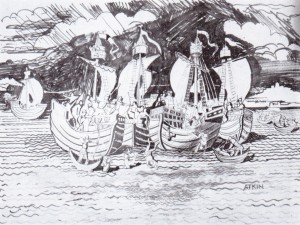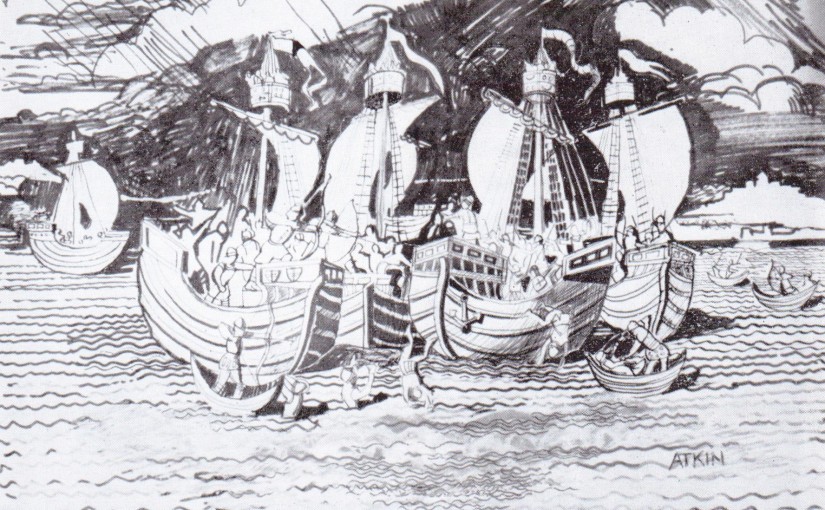The English fleet lay at anchor in the lagoon that stretched from the foot of the hill on which New Winchelsea is built to the cliffs of Rye. The forty or so Cinque Ports built ships were a hive of activity, preparations for battle were well under way. Word had come that a great force of Spanish ships were passing along the Kent coast having come from Sluys in Belgium where they had loaded their ships with many men and materials with which to effect raids on England.
Fears that raiding would take place on these shores had prompted the King to act, his fleet was ordered to stand by at Winchelsea, and it was there he joined it, leaving the Queen at Lord Echyngham’s house in Udimore.
What a brave sight those fine vessels must have made as they passed in single file out of the mouth of the harbour, that then served Rye and Winchelsea, into the bay. Large crowds on the Cadborough Cliffs, including the Queen and her party, watched them leave. It was a fine clear August day in 1350,
Edward III was on the throne, and it was he, leading his brave ships into battle.
The archers and stonecastcrs in the Spanish fleet, which was probably forty or more in number, had a great advantage over their English counterparts. The small castle-like structures at the mast heads of the invaders were much higher than those on the Cinque Ports vessels. The reason for this was the respective sizes of the ships, the Spanish being deep-sea fishermen had built very large ships whereas the English fishing requirement were for shallow draft vessels, the men of war were of similar proportions.

The wind was favourable to the Spaniards, they could easily have avoided an engagement by bearing south-west and letting their greater speed move them out of reach of the English. Instead they came straight on, probably with the intentions of defeating the Cinque Ports Fleet and then going on to loot the two Ancient Towns.
In a head-on collision with one of the invaders, the King’s ship was badly damaged, with his men madly bailing out the water which poured in through great splits in the side of the vessel, the King was forced to break off his engagement. However, once free from his foe, the leaks were stopped and the King was able to rejoin the fray. Small battles were taking place all over Rye Bay by this time, but due mainly to the bravery of the English fighting man, the tide of battle slowly swung in favour of the Cinque Ports Fleet. The King, however, was in terrible trouble, after ramming another and even larger Spanish vessel, his ship burst at the seams and was sinking fast. With bravery, born of fear and desperation, the King’s Knights gathered about him and with one mighty assault, they boarded the Spaniard and threw their enemies into the sea. They were only just in time, as they secured the Spanish vessel their own gallant ship sunk below the waves, ending her life on the bed of Rye Bay.
Fearless acts of heroism were performed by the English over the entire field of battle and by dusk victory was in their grasp. One ship, however, was still locked in battle with the largest of the Spanish ships, unable to break off the engagement because her bow was buried deep into the side of her adversary and being prevented, by weight of numbers, to board the Spaniard. The ship of Rye was carried far out to sea by the mighty sails of the larger vessel. All seemed lost for these men, as none of the other Cinque Ports ships had seen the incident, they were unable to go to their aid. The day was saved by one, Hanequin, who, taking his sword between his teeth, leapt onto the Spanish man of war, fought his way single handed to the foot of the mighty mast and slashed the hawser that held up the sail. With its sails falling over its decks, the Spanish ship came to a standstill. The men of Rye took advantage of the situation and swarmed to the attack. The ship was cleared of Spaniards and the triumphant men of Rye returned to harbour with their prize. In all about twenty four Spanish ships were captured, the remainder either sunk or fled.
So ended the BATTLE OF RYE BAY.
From the January 1966 Issue of “Rye’s Own”
